
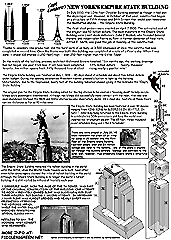

Empire State Building - $$3.95
The Empire State Building was started in 1930 and finished in 1931 by the Starret Brothers and Eken Contracting firm known for their reputation of building quickly. They got their supplies from all over the world. Steel from Pittsburgh, limestone and granite from Indiana, and marble from England. The total cost of the Empire State Building was about 41 million dollars.
The New York City Empire State Building

The Empire State Building was started in 1930 and finished in 1931 by the Starret Brothers and Eken Contracting firm known for their reputation of building quickly. They got their supplies from all over the world. Steel from Pittsburgh, limestone and granite from Indiana, and marble from England. The total cost of the Empire State Building was about 41 million dollars.
The Empire State Building eclipsed the famed Chrysler Building by 200 feet to become the world’s tallest building in 1931 at 1,252 feet. This record was retained for 41 years, longer than any other building, until the World Trade Center Towers were constructed in 1972. Amazingly, within only 27 months the Empire State Building was designed, engineered, erected, and ready for tenants. Including Sundays and holidays, the total time of construction was a year and 45 days.
No structure of this magnitude has since matched this rate of ascent. During peak activity nearly 3,500 workers enabled the building to rise over a story per day. Six months into construction the 60,000-ton steel frame topped off at the 86th floor. The fully enclosed structure including the mooring mast was completed 5 months later.
Supervision of workers was so meticulous that foremen cataloged the hours and work of each man. These reports were compiled daily to form a complete record of each day’s activities. At the peak of construction, nearly 500 loads per day of various materials, machinery and equipment were unloaded within the building to facilitate rapid construction. Railroad tracks on newly constructed stories allowed small transport cars to distribute the materials.
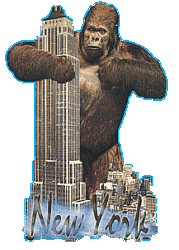
Captn’, Lookin’ real good! I pass the Empire State Building every morning and it looks like you even got the coloring right. Also,those ideas about the 3D city skylines sound tres cool. BB
Captain Sir: Empire State Building is truly BOSS (haven’t heard that in a while). I had no problems other than those I created for myself. The addition of the H-shaped formers is perfect. I have learned with your buildings that scoring accurately and deeply goes a long way to getting the proper effect. I have one protrusion in an H shape in the building that is just a little out of square and dang it...it shows. These things demand perfection. Great job. Thanks. Dave C
Interesting subject, easy to build, educational and a good measure of fun to boot. Congrats, CG
How about printing the WTS towers on clear ink-jettable overhead transparency stock, and cutting off tables and using invisible table to assemble? Might look pretty ghostly...Jim F
There is also available the almost clear "Velum" paper. I printed a FG Corsair out on this, awesome cobalt blue effect. When placed near a lamp the light hits it just right. I’m gonna try the WTC model on the "Velum" this weekend.
Empire State Building
Architecture
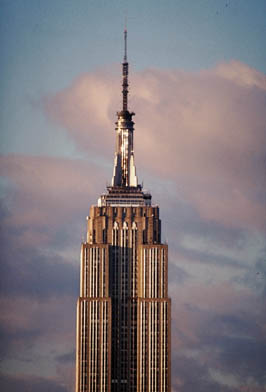 The
built-up columns at the building’s base were the heaviest pieces
of steel used in building construction at that time. The Empire
State Building was the first tall building to need two riser shafts.
This was due to the enormous floor areas of the tower stories.
Seven miles of elevator shaft houses 73 elevators, allowing travel
of up to 80 stories in a minute. The total length of elevator
hoisting, compensating and governor ropes is 636,361 feet or over
120 miles.
The
built-up columns at the building’s base were the heaviest pieces
of steel used in building construction at that time. The Empire
State Building was the first tall building to need two riser shafts.
This was due to the enormous floor areas of the tower stories.
Seven miles of elevator shaft houses 73 elevators, allowing travel
of up to 80 stories in a minute. The total length of elevator
hoisting, compensating and governor ropes is 636,361 feet or over
120 miles.
The exterior of the building alone boasts 200,000 cubic feet of Indiana limestone and granite, 10 million bricks and 730 tones of both aluminum and stainless steel. Originally the mooring mast was equipped with an airship load for dirigibles. After two attempts, the pad was deemed dangerous and stripped from the building. Contrary to popular belief, this decision was not based on the apparent lateral loads the airship would create, thus endangering the structure.
In fact, a moored airship would produce a lateral load of only 50,000 tons compared to wind loads on the north side of the building that exceeded 200,000 tons. In 1931, Architect Richmond H. Shreve claimed a wind blowing with 4,500,000 pounds of pressure would be needed to knock the 365,000-ton building over.
An extensive mail chute system, consisting of 396 openings for deposit, services all floors of the building. The onset of the Great Depression during construction halved the anticipated building cost to a mere $24,718,000. When completed, the Empire State Building’s address at 350 Fifth Avenue (site of the original Waldorf-Astoria Hotel) was far from New York’s dense business district.
Two years
after it opened for rentals in 1931, the building’s location and
the nation’s poor economic state was evident in the building’s
three-quarters or 56 floors of vacant space.
Its 2.1 million square feet of available office space was nearly
twice the area of the Equitable Building, New York’s next largest
office edifice.
The unprecedented height of the building led to many interesting
comparisons. For example, if the Eiffel Tower were piled atop
the Great Pyramid of Cheops, the Empire State Building would still
exceed their combined height by 38 feet.

Contrary to popular legend, pennies tossed off the building’s observation deck will never reach the street below, much less cause danger to any pedestrians. Numerous setbacks on the building’s tower quite naturally collect objects dropped from the top due to the wind affect on the structure. The wind pushes objects against the face of the building, a phenomena that also accounts for the apparent "upward travel" of rain when storms are observed from the upper floors.
The building’s spire acts as a lightning rod for the entire city. It is struck in excess of 100 times per year. Some 3.8 million people visit the Empire State Building’s observation deck annually, making it the most frequently visited and most recognizable skyscraper in the world.
That pesty King Kong!!
Of the over 200 movies in which this landmark is featured, none is more famous than King Kong (1933) in which the monster sought refuge on the building’s tower. And let’s not forget Peter Jackson’s 2005 remake of King Kong staring Naomi Watts, and Jack Black. Among it’s many accomplishments, this remake won 3 oscars for visual effects and sound.
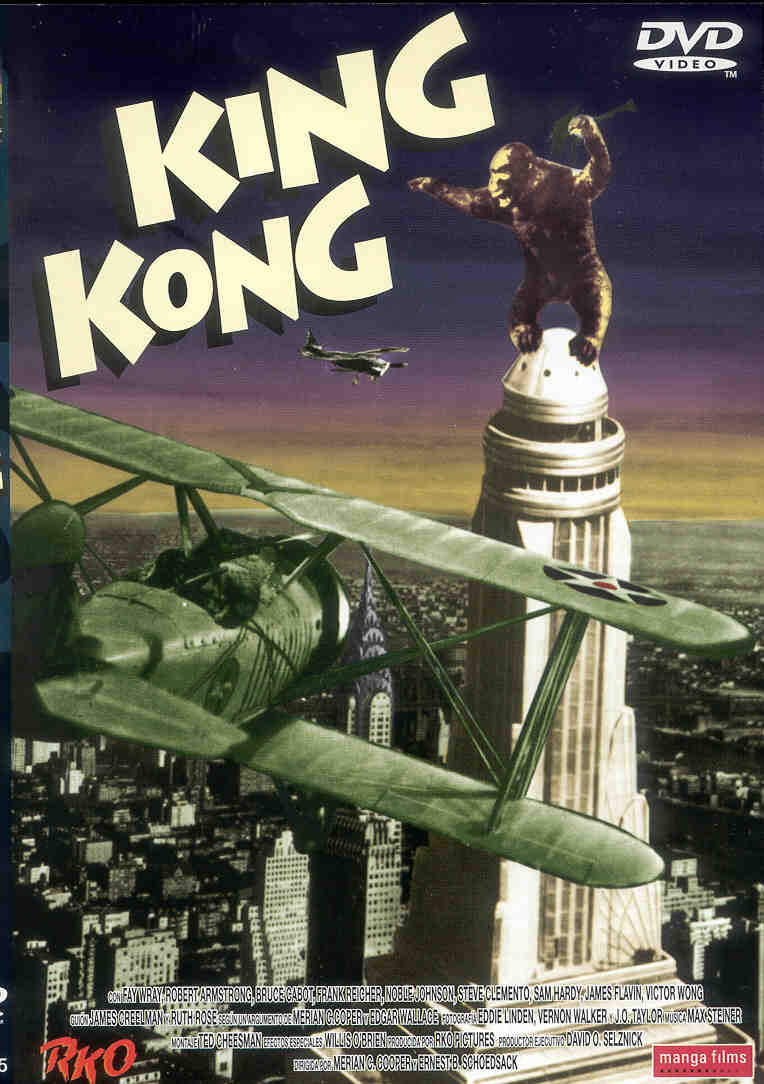
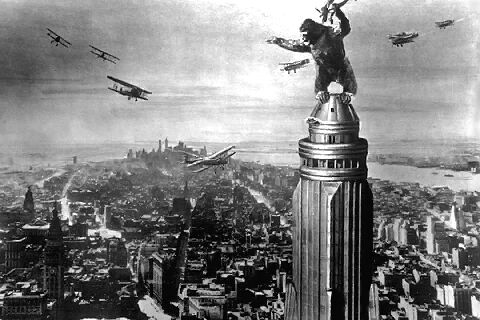

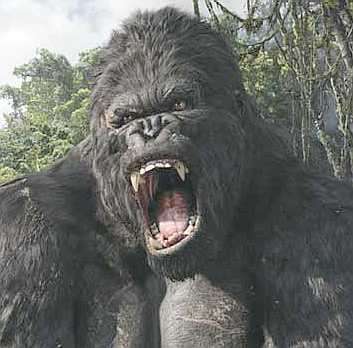
What sort of planes were those that shot down King Kong?
The planes used to topple King Kong from the top of the Empire State Building were four basic navy training models, Curtiss 02C-2 and Navy NY. The scenes were shot using these real planes, miniatures and a full-scale mock-up which featured a Vickers-style gun on a swivel mount which was used for close shots of the pilots (Cooper and Schoedsack) firing at Kong.
Director Schoedsack donated $100 to the Officers’ Mess fund at Floyd Bennet Field to secure the pilots and their craft. He gave each of the pilots $10 under the table and they were so happy with the extra money that they decided to do something special to show how much they appreciated it. As Schoedsack shot the planes approaching him he realized that they were actually linked together by lines decorated by colorful flags. Needless to say that scene had to be re-shot. Cooper and Schoesdsack were the Producer and Director.
A couple photos the the Captain’s final mock up.
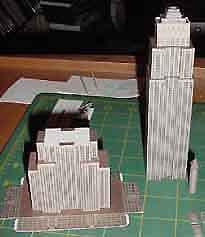 |
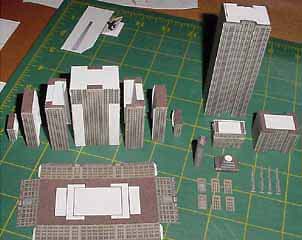 |
The Empire State Building has some impressive statistics such
as having 6,500 windows and 250 staff members. Every year there
is a race to see who can get to the top by climbing its 1,860
steps. Or you can get to the top via elevator (seventy-three)
or one of the eight escalators. The Empire State Building is powered
by 2,500,000 feet of electrical wire. The sinks and toilets connect
to 70 miles of pipes.
Bomber Crashes in to the Building:
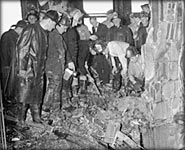
Those who were around on July 28, 1945 would remember the crash of an Army Air Corps B-25 bomber into the 79th floor of the Empire State Building. Fourteen people died and $1 million damage was done to the building...one of the plane’s engines cut through the building entirely.
Damage was confined to the outer wall, however, thus preserving Empire State’s structural integrity.
Nonetheless it was front page news in New York City and you might check your local library for old copies of New York daily papers on microfilm.
Documentary about the Empire State Building


